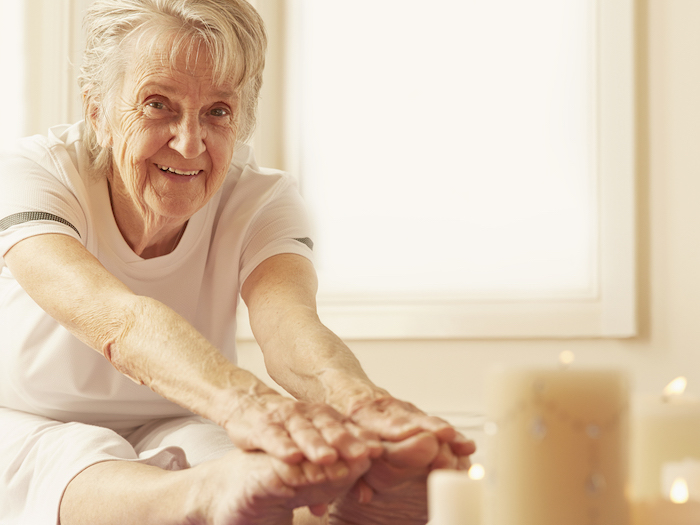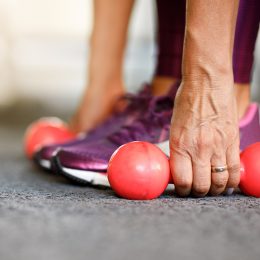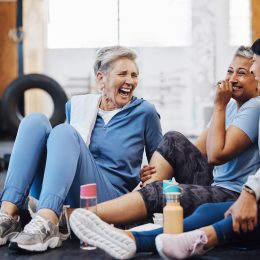4 Stretching Myths You Need to Stop Believing
Learn the truth now to avoid pain, stiffness, and mobility issues later.

Flexibility, or having a full range of motion throughout your joints, is an often overlooked but essential component of fitness. And that’s especially true as you get older.
As children, because of softer bones and plenty of cartilage between them, we’re generally at our most flexible. As our skeletons develop, our bones harden and fuse together. And with use over time, our joints age, and mobility issues start creeping in. In fact, the U.S. Census Bureau found that mobility problems, like trouble walking or climbing, are the single most common disability that affects people ages 65 and older.
Adding stretching to your weekly routine can help joints move more easily and ease tight muscles, but probably not the same reach-and-hold technique you learned in high school. The best stretches for you will depend on your body and goals, but there are some universal misconceptions that need clearing up. Here, we set the record straight and provide a variety of stretching exercises so you can find ones that fit your needs.
Add SilverSneakers to your wellness routine! Classes and events are happening right now at participating gyms, online through SilverSneakers LIVE, and at community centers near you. Activate your free online account to get started.
Myth #1: You’re Either Naturally Flexible or You’re Not—Stretching Doesn’t Help Much
The idea of stretching wouldn’t have lasted this long—and top athletes wouldn’t do it—if it didn’t work. The trouble is when people think stretching alone will make you flexible, says Sarah Feilders, a flexibility expert and creator of the Extensa Method.
“Flexibility is an achievable state of being, while stretching is an exercise technique,” Feilders says. “To achieve flexibility, we need to perform certain exercises, including stretching.”
Many people think if they’re not already flexible, they can’t do flexibility exercises that incorporate stretching, says Heidi Kristoffer, a yoga instructor in New York City and creator of CrossFlowX.
But as with any exercise, the key is to start and improve over time. “I couldn’t even touch my toes when I started yoga, but I work hard at it,” Kristoffer says. “You don’t need a ballerina’s flexibility to enhance your life.”
So, where should an inflexible person begin? Start by talking to your doctor about safe exercise if you have a chronic condition (including osteoporosis), balance issues, or injuries. As you stretch, breathe deeply, and go slowly. Listen to your body, and never force a movement that causes pain.
The good news is you can ease tension in your neck, back, and legs without standing up or getting down on the floor. Try this 11-minute chair flow.
If you’re looking to stretch and strengthen at the same time, check out our guide to five yoga poses every older adult should know.
Myth #2: You Shouldn’t Stretch Before Your Workout, Only After
You may have heard that stretching before your muscles are warm is a bad idea. And there’s some truth to that: Performing static stretches—reaching and holding in one position—is not recommended and has even been shown to hurt workout performance.
But static stretching is not the only way to stretch. “There are many ways to increase mobility prior to an activity,” says Aaron Brooks, a biomechanics expert and owner of Perfect Postures in Newton, Massachusetts.
Feilders agrees, adding that so-called active or dynamic stretching—where the limbs are moving rather than reaching and holding—is encouraged before exercise. “Dynamic stretches as part of your warmup help lubricate the joints, promote blood flow and circulation, and prepare the body mentally and physically for the work ahead.”
The goal of dynamic stretching is to replicate the same moves you’ll do in your workout, helping you prevent injury. Try these five dynamic stretches to properly warm up your body.
Myth #3: You Shouldn’t Stretch Your Back
Research shows more than 80 percent of the population will experience lower back pain at some point in their lives. And when that happens, most people believe that exercising the back will make the pain worse.
“People are really scared of the back,” Kristoffer says. “They think, ‘I’m injured so I’m done for life.’ But that’s giving yourself a life sentence of back pain.”
Anyone suffering from back pain or stiffness should work to improve both their strength and flexibility. One of Kristoffer’s favorite exercises for the back is a modified cat-cow that can be done right in your chair. Here’s how to do it:
Subscribe to our newsletter
It's quick and easy. You could be one of the 13 million people who are eligible.
Already a member? Click to discover our 15,000+ participating locations.
Follow Us
- Sit tall in your chair with your back away from the backrest and your feet flat on the floor. Place your hands on your thighs.
- Inhale, lifting your chest while moving your butt back and your head up and back as far as comfortable. You should have a slight bend in your back. This is the cow position.
- From here, slowly exhale, bringing your belly button toward your spine and rounding your back so your head comes forward as you do. Imagine you are rounding your torso over a beach ball in front of you. This is the cat position.
- Repeat this back and forth for three to five breaths.
You can also perform cat-cow standing or any of these other yoga poses that ease back pain.
If your back pain is accompanied by other symptoms, such as fever, unintentional weight loss, or incontinence, check in with your doctor.
Myth #4: Stretching One Muscle Group Will Relieve Strain in That Area
If your hip flexor is tight, you should just stretch it, right? Not exactly, Brooks says.
When you’re tight or sore in one spot, the source may be another muscle group altogether. For example, lower back pain isn’t necessarily from forgetting to stretch your back—the culprit could be tight hip flexors. And knee pain may not mean a problem with your knees—it could indicate tightness or weakness in your hamstrings.
The bottom line: Everything’s connected. Stretch one area, and another might benefit too. Your best bet for avoiding stiffness and increasing range of motion is to commit to a regular stretching routine. SilverSneakers fitness expert David Jack recommends doing these four stretches every day.
Activate Your FREE SilverSneakers Online Account
Get hundreds of free SilverSneakers On-Demand videos and stay in touch with us by creating your free online account. You don’t have to be a SilverSneakers member to get on-demand workout videos, health and fitness tips from SilverSneakers, and more.
SilverSneakers members can go to thousands of nationwide gyms and fitness locations, plus take SilverSneakers LIVE online classes led by specially trained instructors and designed for all fitness levels and abilities – at no additional cost. If you have a Medicare Advantage plan, it may include SilverSneakers. Check your eligibility here.
Already a member? Get your SilverSneakers member ID, search for locations near you, and all the health and wellness resources you need by logging in to your online member account here.





